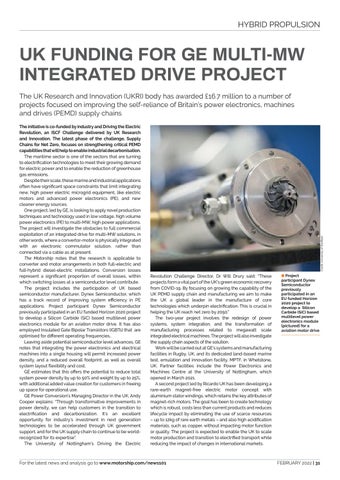HYBRID PROPULSION
UK FUNDING FOR GE MULTI-MW INTEGRATED DRIVE PROJECT The initiative is co-funded by industry and Driving the Electric Revolution, an ISCF Challenge delivered by UK Research and Innovation. The latest phase of the challenge, Supply Chains for Net Zero, focuses on strengthening critical PEMD capabilities that will help to enable industrial decarbonisation. The maritime sector is one of the sectors that are turning to electrification technologies to meet their growing demand for electric power and to enable the reduction of greenhouse gas emissions. Despite their scale, these marine and industrial applications often have significant space constraints that limit integrating new, high power electric microgrid equipment, like electric motors and advanced power electronics (PE), and new cleaner energy sources. One project, led by GE, is looking to apply novel production techniques and technology used in low voltage, high volume power electronics (PE) to multi-MW, high power applications. The project will investigate the obstacles to full commercial exploitation of an integrated drive for multi-MW solutions, in other words, where a convertor-motor is physically integrated with an electronic commutator solution, rather than connected via a cable as at present. The Motorship notes that the research is applicable to converter and motor arrangements in both full-electric and full-hybrid diesel-electric installations. Conversion losses represent a significant proportion of overall losses, within which switching losses at a semiconductor level contribute. The project includes the participation of UK based semiconductor manufacturer, Dynex Semiconductor, which has a track record of improving system efficiency in PE applications. Project participant Dynex Semiconductor previously participated in an EU funded Horizon 2020 project to develop a Silicon Carbide (SiC) based multilevel power electronics module for an aviation motor drive. It has also employed Insulated Gate Bipolar Transistors (IGBTs) that are optimised for different operating frequencies.. Leaving aside potential semiconductor level advances, GE notes that integrating the power electronics and electrical machines into a single housing will permit increased power density, and a reduced overall footprint, as well as overall system layout flexibility and cost. GE estimates that this offers the potential to reduce total system power density by up to 50% and weight by up to 25%, with additional added value creation for customers in freeing up space for operational use. GE Power Conversion’s Managing Director in the UK, Andy Cooper explains: “Through transformative improvements in power density, we can help customers in the transition to electrification and decarbonization. It’s an excellent opportunity for industry’s investment in next generation technologies to be accelerated through UK government support, and for the UK supply chain to continue to be worldrecognized for its expertise”. The University of Nottingham’s Driving the Electric
Credit: University of Sheffield
The UK Research and Innovation (UKRI) body has awarded £16.7 million to a number of projects focused on improving the self-reliance of Britain’s power electronics, machines and drives (PEMD) supply chains
Revolution Challenge Director, Dr Will Drury said: “These projects form a vital part of the UK’s green economic recovery from COVID-19. By focusing on growing the capability of the UK PEMD supply chain and manufacturing we aim to make the UK a global leader in the manufacture of core technologies which underpin electrification. This is crucial in helping the UK reach net zero by 2050.” The two-year project involves the redesign of power systems, system integration, and the transformation of manufacturing processes related to megawatt scale integrated electrical machines. The project will also investigate the supply chain aspects of the solution. Work will be carried out at GE’s systems and manufacturing facilities in Rugby, UK, and its dedicated land-based marine test, emulation and innovation facility, MPTF, in Whetstone, UK. Partner facilities include the Power Electronics and Machines Centre at the University of Nottingham, which opened in March 2021. A second project led by Ricardo UK has been developing a rare-earth magnet-free electric motor concept with aluminium stator windings, which retains the key attributes of magnet-rich motors. The goal has been to create technology which is robust, costs less than current products and reduces lifecycle impact by eliminating the use of scarce resources – up to 12kg of rare earth metals – and also high acidification materials, such as copper, without impacting motor function or quality. The project is expected to enable the UK to scale motor production and transition to electrified transport while reducing the impact of changes in international markets.
For the latest news and analysis go to www.motorship.com/news101
8 Project participant Dynex Semiconductor previously participated in an EU funded Horizon 2020 project to develop a Silicon Carbide (SiC) based multilevel power electronics module (pictured) for a aviation motor drive
FEBRUARY 2022 | 31






